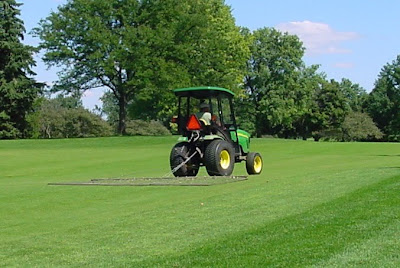We have received a couple of inquiries into the condition of the driving range tee. There are a few situations with the tees we are battling with at this time. Two of them deal with irrigation system maladies, the other deals with a turf condition effecting the management of the turf.
We'll start with the irrigation system maladies. One of the problems is a result of the winterization of the irrigation system. The line that runs along the front of the front tee was not fully winterized. Water remained in the pipe through the the winter and froze, causing a large crack in the pipe for a large portion of the distance it stretches.
The sod that was dug up to inspect the pipe.
The company that did the winterization was out to inspect the pipe, and will be returning shortly to repair the damaged length. This problem only effects the line on the front of the front tee. There are irrigation heads that water the rough in front of the tee have been changed to full circle heads to water the tee as well to help this area along. When the pipe is completely fixed the area will be re-sodded and fully repaired.
The other irrigation problem is not as major as the first, but it has resulted in a few areas of wilt on the middle tee. This issue involves 2 lines on the back of the middle tee box. The valves controlling these two lines are not shutting off properly when they are run automatically. We have open them up to flush water through the valve to remove any dirt or rocks that may be interfering. The next step is to take them apart to identify which part is failing.
These two valves are currently being operated manually to water these areas.
The last issue that is present on the driving range tees, and likely to most detrimental to the health of the tee, is an organic matter layer on the surface of the soil. This organic matter layer is called thatch, which is undecomposed stems of the turfgrass.
This picture shows the thatch material between turf on top and dark soil.
This thatch layer is a result of the grass chosen for the tee. The grass chosen for the tees is an aggressive variety of bentgrass, called T-1, to aid in the recovery of divots. The aggressive nature of the grass also results in the more rapid production of thatch. To manage this thatch, aerification will be necessary to remove the material and provide holes for air and water to move into the soil. The benefits of aerification can be seen on the back driving range tee. The back tee was aerified after the fireworks event earlier this year.














































